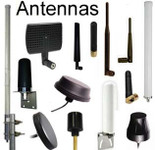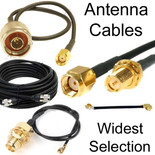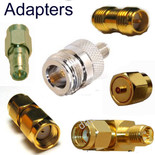Antennas, Antenna Cables, Wireless Products: Technical Articles
Bluetooth Low Energy (BLE) Compared to Bluetooth for Internet of Things
Bluetooth Compared to BLE for IoT
BLE is power-conservative compared to Bluetooth
Bluetooth Low Energy (BLE), also known as Bluetooth Smart, is a power-conserving variant of the classic Bluetooth technology. Originally introduced with Bluetooth 4.0, BLE has become a popular choice for many applications, primarily because of its low power consumption and robust performance.
BLE is a wireless communication protocol designed for short-range communication between devices. While traditional Bluetooth is used for transmitting larger amounts of data continuously (like streaming music), BLE is optimized for sending small amounts of data sporadically, making it perfect for applications where conserving battery life is crucial.

BLE: Key Features:
- Low Power Consumption: BLE's most prominent feature is its minimal energy use. Devices using BLE can last for months or even years on a tiny coin-cell battery.
- Short Range: Typically, BLE can cover distances up to 100 meters, but this can vary based on the environment and the device in use.
- Fast Connection: BLE devices can connect rapidly, usually within milliseconds, which is essential for applications that require immediate data transfer without a constant connection.
- Compatibility: Most modern smartphones, tablets, and computers support BLE, allowing for a wide range of potential use cases.
Characteristics of BLE
This form of Bluetooth has been engineered with a reduction in data rate (0.27Mbps) and transmitter power to support low-power applications. Power consumption is up to 99% lower than that of standard Bluetooth depending on the application or device used. It operates at a frequency of 2.4GHz on an ISM band. It is important to note that BLE has a lower operating range than Bluetooth of just 50m. Though BLE is more energy efficient than Bluetooth, ZigBee and Wi-Fi, it is not designed for file transfer but rather small chunks of data. BLE is also secure as it is engineered with government grade message encryption, 128-bit AES-CCM.
Alongside Bluetooth Mesh, BLE is a refinement of Bluetooth which is now commercially available and is noted in particular for its lower energy consumption. It was released with Bluetooth v4.0. Classic Bluetooth is a wireless protocol and short-link radio technology developed in the late 1980s through 1990 in Sweden. It is overseen by the Bluetooth Special Interest Group (SIG)
BLE Protocol in IoT
This wireless personal area network technology has performed especially well in supporting a variety of IoT applications due to its low energy consumption, conformity to the transfer of simple packets of data and reliable security and specificity. These features make it an ideal choice for small scale IoT applications such as wearables, for which a burgeoning consumer market is expected.
BLE is positioning itself as the preferred and most compatible option for IoT networking and SIG has developed a number of profiles which specify how BLE will perform in supporting particular IoT applications.
Applications of bluetooth-antennas Low Energy in IoT
BLE has quickly become the go-to solution for a plethora of applications. From healthcare to smart home technologies and wearables, the breadth of BLE applications speaks volumes about its versatility. Let’s delve deeper into this technology and the areas it's making an impact.
1. Wearable Fitness and Health Devices
The wearable tech industry, synonymous with innovations like fitness trackers and smartwatches, thrives on BLE. The reason? BLE's minimal energy consumption ensures these devices can run for days, sometimes weeks, on a single charge. This technology facilitates the tracking of vital statistics - heart rate, sleep patterns, steps taken, and more, all in real-time.
2. Smart Home Automation
Imagine walking into your home and having the lights adjust to your mood or the temperature set just right. BLE empowers smart home devices, from smart thermostats to Bluetooth-controlled lights, offering a harmonious blend of comfort and energy efficiency.
3. Asset Tracking and Beacons
Whether it's keeping track of valuable items or ensuring you never lose your car keys again, BLE tags have emerged as the ideal solution. Moreover, businesses are harnessing BLE beacons to provide location-based services, enhancing customer engagement.With IoT Asset Tracking, processes can be carried out with higher speed and precision.
4. Medical Devices
Healthcare and medical device integration is another realm where BLE shines brightly. Glucometers, blood pressure monitors, and even some implantable devices have started to incorporate BLE for effortless data transfer, ensuring timely medical interventions.
5. Automotive Industry
The future of driving involves more than just autonomous vehicles. From keyless entry systems to personalized driving settings adjusted via smartphone apps, BLE is steering the automotive industry towards a more interconnected future.
6. Industrial Automation
In large factories and industrial setups, sensors and control systems require efficient, low-energy solutions to communicate. BLE, with its low energy consumption and reliable data transfer, is rapidly becoming the backbone of industrial IoT automation for smart factories.
7. Smart Agriculture
Precision agriculture ( IoT in Agriculture ) is gaining traction, and BLE is at its core. Sensors placed in the field can provide real-time data on soil moisture, climate conditions, and plant health. This data, transferred via BLE, assists farmers in making more informed decisions.
Antennas for Bluetooth Low Energy
Antennas are a crucial component of any wireless system. They determine the range, reliability, and overall performance of the BLE device. When designing or choosing a BLE device, understanding the antenna options is essential.

Types of Antennas:
- PCB Antenna: Integrated directly onto the circuit board, these antennas are cost-effective and offer decent performance for most applications. Their shape and size can be customized to fit the specific needs of the device. The PCB antenna connectors connect to the circuit board via a U.FL cable or MHF4 cable.
- Chip Antenna: These are compact, off-the-shelf components soldered onto the device's circuit board. They are ideal for very space-constrained applications.
- Whip Antenna: These are external antennas, often seen in industrial BLE devices. They offer superior range and performance but can be more prominent and less aesthetically pleasing. Whip antennas typically connect to the circuit board via a U.FL to RP-SMA cable (another specialized connector type). While SMA, RP-SMA, and MMCX are also commonly used cable types for antenna connections, the choice depends on factors like the specific antenna and device.
- Ceramic Antenna: Made from high-performing dielectric materials, these antennas are compact and offer excellent performance. They're commonly used in wearables and other space-constrained devices.
Considerations for Antenna Design:
- Device Size: The device's size can dictate the type and size of the antenna. Smaller devices might opt for chip or ceramic antennas, while larger ones can accommodate whip or PCB antennas.
- Device Use-case: Devices that need a more extended range, like industrial sensors, may benefit from larger, external antennas.
- Environment: If the device operates in an environment with lots of metal or water, it may require an antenna with higher gain or better directionality along with waterproof connectors.
- Interference: In environments with other wireless devices, selecting or designing an antenna that can minimize interference is crucial.
Conclusions
A Focus on BLE's Versatility
In essence, Bluetooth Low Energy isn’t just about 'Bluetooth' or 'Low Energy.' Its utility goes beyond mere wireless connections or energy savings. The true hallmark of BLE lies in its diverse 'applications' spanning across sectors like wearable tech, smart home, healthcare, and industrial automation. Whether it's ensuring the efficiency of medical devices or enhancing customer engagement through asset tracking, BLE remains pivotal. As the technological landscape evolves, one can only anticipate even broader 'BLE applications' making a significant mark in the ever-connected world.
In conclusion, BLE is much more than a wireless communication method; it's a game-changer with a vast range of applications. As we transition to an even more interconnected age, the impact of Bluetooth Low Energy will undoubtedly continue to grow.
Bluetooth Low Energy has revolutionized the way our devices communicate, offering power-efficient, rapid, and reliable connections for a plethora of applications. As with all wireless devices, the antenna plays a pivotal role in the performance of BLE devices. Understanding the various antenna types and design considerations can help in choosing or designing the perfect BLE device for any application.







